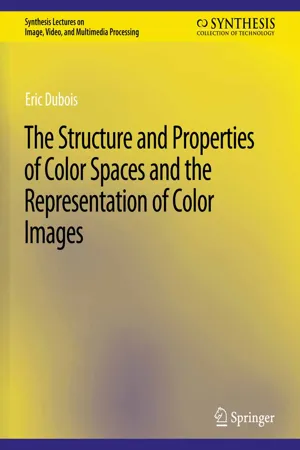
eBook - PDF
The Structure and Properties of Color Spaces and the Representation of Color Images
- English
- PDF
- Available on iOS & Android
eBook - PDF
The Structure and Properties of Color Spaces and the Representation of Color Images
About this book
This lecture describes the author's approach to the representation of color spaces and their use for color image processing. The lecture starts with a precise formulation of the space of physical stimuli (light). The model includes both continuous spectra and monochromatic spectra in the form of Dirac deltas. The spectral densities are considered to be functions of a continuous wavelength variable. This leads into the formulation of color space as a three-dimensional vector space, with all the associated structure. The approach is to start with the axioms of color matching for normal human viewers, often called Grassmann's laws, and developing the resulting vector space formulation. However, once the essential defining element of this vector space is identified, it can be extended to other color spaces, perhaps for different creatures and devices, and dimensions other than three. The CIE spaces are presented as main examples of color spaces. Many properties of the color space are examined. Once the vector space formulation is established, various useful decompositions of the space can be established. The first such decomposition is based on luminance, a measure of the relative brightness of a color. This leads to a direct-sum decomposition of color space where a two-dimensional subspace identifies the chromatic attribute, and a third coordinate provides the luminance. A different decomposition involving a projective space of chromaticity classes is then presented. Finally, it is shown how the three types of color deficiencies present in some groups of humans leads to a direct-sum decomposition of three one-dimensional subspaces that are associated with the three types of cone photoreceptors in the human retina. Next, a few specific linear and nonlinear color representations are presented. The color spaces of two digital cameras are also described. Then the issue of transformations between different color spaces is addressed. Finally, these ideas are applied to signal and system theory for color images. This is done using a vector signal approach where a general linear system is represented by a three-by-three system matrix. The formulation is applied to both continuous and discrete space images, and specific problems in color filter array sampling and displays are presented for illustration. The book is mainly targeted to researchers and graduate students in fields of signal processing related to any aspect of color imaging.
Frequently asked questions
Yes, you can cancel anytime from the Subscription tab in your account settings on the Perlego website. Your subscription will stay active until the end of your current billing period. Learn how to cancel your subscription.
No, books cannot be downloaded as external files, such as PDFs, for use outside of Perlego. However, you can download books within the Perlego app for offline reading on mobile or tablet. Learn more here.
Perlego offers two plans: Essential and Complete
- Essential is ideal for learners and professionals who enjoy exploring a wide range of subjects. Access the Essential Library with 800,000+ trusted titles and best-sellers across business, personal growth, and the humanities. Includes unlimited reading time and Standard Read Aloud voice.
- Complete: Perfect for advanced learners and researchers needing full, unrestricted access. Unlock 1.4M+ books across hundreds of subjects, including academic and specialized titles. The Complete Plan also includes advanced features like Premium Read Aloud and Research Assistant.
We are an online textbook subscription service, where you can get access to an entire online library for less than the price of a single book per month. With over 1 million books across 1000+ topics, we’ve got you covered! Learn more here.
Look out for the read-aloud symbol on your next book to see if you can listen to it. The read-aloud tool reads text aloud for you, highlighting the text as it is being read. You can pause it, speed it up and slow it down. Learn more here.
Yes! You can use the Perlego app on both iOS or Android devices to read anytime, anywhere — even offline. Perfect for commutes or when you’re on the go.
Please note we cannot support devices running on iOS 13 and Android 7 or earlier. Learn more about using the app.
Please note we cannot support devices running on iOS 13 and Android 7 or earlier. Learn more about using the app.
Yes, you can access The Structure and Properties of Color Spaces and the Representation of Color Images by Eric Dubois in PDF and/or ePUB format, as well as other popular books in Technology & Engineering & Electrical Engineering & Telecommunications. We have over one million books available in our catalogue for you to explore.
Information
Table of contents
- Cover
- Title Page
- Copyright Page
- Contents
- Preface
- Notation
- Introduction
- Light: The Physical Color Stimulus
- The Color Vector Space
- Subspaces and Decompositions of the Human Color Space
- Various Color Spaces, Representations, and Transformations
- Signals and Systems Theory for Still and Time-Varying Color Images
- Concluding Remarks
- Semigroups and Groups
- Equivalence Relations
- Vector Spaces
- Lattices
- Bibliography
- Author’s Biography